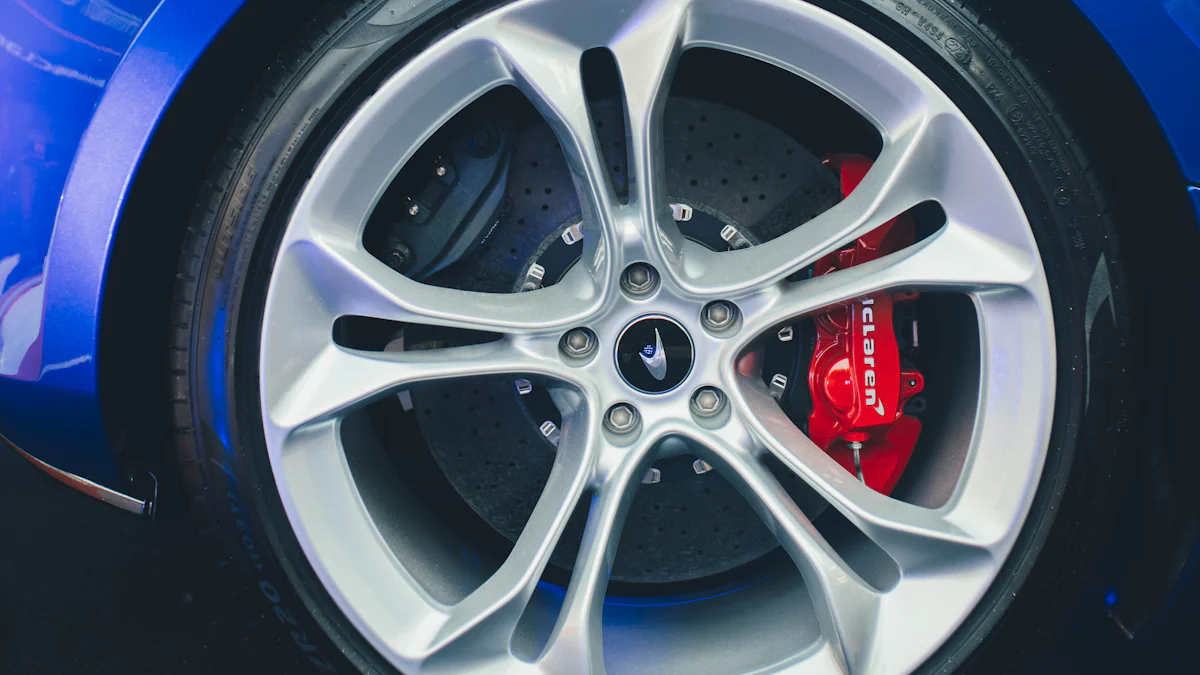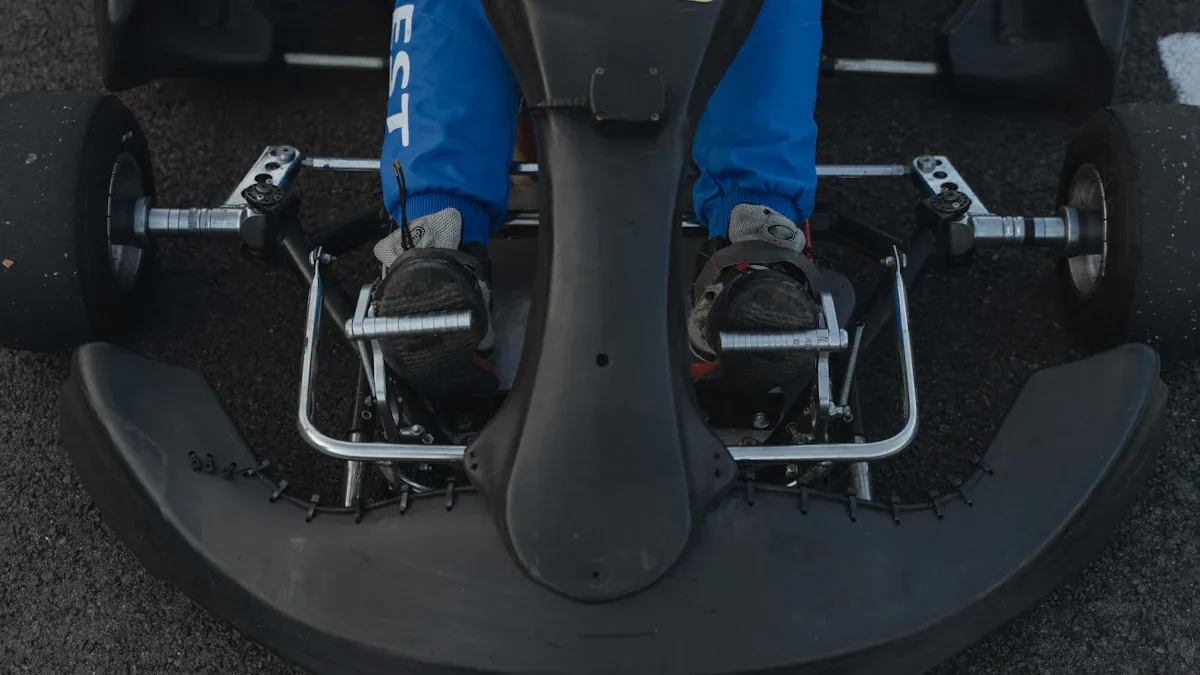
Maintaining your 16×9 steel wheels is essential for ensuring their durability and safety. Steel wheels are known for their exceptional strength, making them a reliable choice for vehicles. However, neglecting proper care can lead to rust, corrosion, and structural damage over time. Regular maintenance not only extends the lifespan of your wheels but also saves you money by reducing repair or replacement costs. By keeping your wheels clean, inspecting them frequently, and protecting them from environmental factors, you can preserve their performance and enhance your driving experience.
Key Takeaways
- Regular cleaning of your 16×9 steel wheels is crucial to prevent dirt buildup and corrosion; aim to clean them at least once a month.
- Apply protective coatings, such as wax or rust inhibitors, to shield your wheels from moisture and extend their lifespan.
- Conduct routine inspections to identify early signs of rust or damage; this proactive approach can save you from costly repairs.
- Tailor your maintenance routine to seasonal changes, ensuring your wheels are protected from harsh winter conditions and summer heat.
- Properly prepare and store your wheels in a cool, dry place to prevent rust and damage during off-seasons.
- Address any scratches or chips in the wheel’s coating immediately to maintain its protective barrier against rust.
Cleaning and Washing 16×9 Steel Wheels

Keeping your 16×9 steel wheels clean is a fundamental step in maintaining their durability and appearance. Regular cleaning not only enhances the aesthetic appeal of your wheels but also prevents the buildup of dirt, grime, and corrosive substances that can lead to long-term damage.
Importance of Regular Cleaning
Cleaning your wheels regularly ensures they remain in optimal condition. Dirt, brake dust, and road salt can accumulate on the surface, causing corrosion over time. By removing these contaminants, you protect the structural integrity of your wheels and maintain their performance. Clean wheels also contribute to the overall look of your vehicle, giving it a polished and well-maintained appearance.
Tip: Clean your wheels at least once a month to prevent stubborn stains and rust from forming.
Recommended Cleaning Products and Tools
Using the right products and tools is essential for effective cleaning. Here are some recommendations:
- Soap and Water: A simple solution of soap and water works wonders for cleaning steel wheels. It is gentle yet effective in removing dirt and grime.
- Non-Acidic Wheel Cleaner: Choose a cleaner specifically formulated for steel or alloy wheels to avoid damaging the finish.
- Soft Brush or Cloth: Use a soft-bristled brush or microfiber cloth to scrub the surface without scratching it.
- Product for Preventing Dirt Adhering: After cleaning, apply a product designed to prevent dirt from sticking. This not only keeps your wheels cleaner for longer but also gives them a shiny finish.
Pro Tip: Avoid harsh chemicals or abrasive tools, as they can damage the wheel’s coating and reduce its lifespan.
Step-by-Step Cleaning Process
Follow these steps to clean your 16×9 steel wheels effectively:
- Cool Down the Wheels: Ensure the wheels are cool to the touch before starting. Cleaning hot wheels can cause burns and may damage the finish.
- Rinse Thoroughly: Use a hose to rinse off loose dirt and debris. This step prevents scratching during scrubbing.
- Apply Soap Solution: Mix soap and water in a bucket. Apply the solution generously to the wheels using a soft brush or cloth.
- Scrub Gently: Focus on areas with heavy dirt buildup. Pay attention to crevices and lug nut holes where grime tends to accumulate.
- Rinse Again: Wash off the soap and loosened dirt with clean water. Ensure no residue remains.
- Dry Completely: Use a clean microfiber cloth to dry the wheels. This step prevents water spots and rust formation.
- Apply Protective Coating: Finish by applying a product that prevents dirt from adhering. This step adds a layer of protection and enhances the wheel’s shine.
Reminder: Regular cleaning not only preserves the appearance of your wheels but also extends their lifespan by preventing rust and corrosion.
Rust Prevention for 16×9 Steel Wheels

Rust can significantly impact the performance and lifespan of your 16×9 steel wheels. Preventing rust not only ensures their durability but also maintains their structural integrity and appearance. By understanding the causes of rust, applying protective measures, and addressing early signs, you can keep your wheels in excellent condition.
Causes of Rust and Corrosion
Rust forms when steel reacts with oxygen and moisture, creating iron oxide. This process accelerates in environments with high humidity, road salt, or exposure to chemicals. For steel wheels, dirt and grime can trap moisture, increasing the risk of corrosion. Scratches or chips in the paint coating expose the metal underneath, making it vulnerable to rust.
Fact: Steel wheels resist rust effectively as long as their surface remains covered with paint or a protective layer. Damage to this coating increases the likelihood of corrosion.
To minimize rust, avoid prolonged exposure to water or salty conditions. Regular cleaning and inspections help remove contaminants that contribute to corrosion.
Applying Protective Coatings
Protective coatings act as a barrier between the steel and environmental elements. These coatings prevent moisture and oxygen from reaching the metal surface, reducing the risk of rust. Applying a protective layer is a simple yet effective way to extend the life of your 16×9 steel wheels.
Here are some common protective options:
- Paint Coating: A high-quality paint layer shields the steel from moisture and air. Ensure any scratches or chips are promptly repainted to maintain protection.
- Wax or Sealant: Applying a wax or sealant after cleaning creates an additional layer of defense. These products repel water and dirt, keeping your wheels cleaner for longer.
- Rust Inhibitor Spray: Use a rust inhibitor spray designed for steel wheels. This product provides long-lasting protection against corrosion.
Tip: Reapply protective coatings periodically, especially after cleaning or during seasonal changes, to maintain their effectiveness.
Identifying and Addressing Early Signs of Rust
Early detection of rust can save you from costly repairs or replacements. Inspect your 16×9 steel wheels regularly for signs of corrosion. Look for discoloration, rough patches, or flaking paint, as these indicate the onset of rust.
If you notice rust, take immediate action:
- Clean the Affected Area: Remove dirt and debris using soap and water. Dry the area thoroughly to prevent further moisture exposure.
- Sand the Rust: Use fine-grit sandpaper to gently remove rust from the surface. Be careful not to damage the surrounding paint.
- Apply Rust Converter: A rust converter chemically neutralizes rust and prevents it from spreading. Follow the product instructions for best results.
- Repaint or Coat: After treating the rust, repaint the area or apply a protective coating to restore the wheel’s defense.
Reminder: Regular inspections and prompt action can prevent minor rust issues from escalating into severe damage.
By understanding the causes of rust, using protective coatings, and addressing early signs, you can ensure your 16×9 steel wheels remain in top condition. These steps not only enhance the longevity of your wheels but also improve your vehicle’s safety and performance.
Regular Inspections for 16×9 Steel Wheels
Regular inspections play a vital role in maintaining the safety, performance, and longevity of your 16×9 steel wheels. By identifying potential issues early, you can prevent costly repairs and ensure your wheels remain in excellent condition. Inspections also help uncover hidden problems, such as rust or structural damage, that may compromise your vehicle’s safety.
Why Routine Inspections Matter
Routine inspections are essential for detecting and addressing problems before they escalate. Steel wheels are durable, but they can still develop issues like cracks, dents, or rust over time. Regular checks allow you to spot these defects early and take corrective action. This proactive approach not only extends the lifespan of your wheels but also enhances your vehicle’s overall safety and performance.
Fact: Identifying and fixing minor issues during inspections can save you from expensive repairs or replacements later.
Inspections also ensure that your wheels maintain their structural integrity. Damaged wheels can affect your vehicle’s handling, leading to unsafe driving conditions. By inspecting your wheels regularly, you reduce the risk of accidents caused by wheel failure.
Key Areas to Inspect
When inspecting your 16×9 steel wheels, focus on specific areas that are prone to wear and damage. A thorough inspection should include the following:
- Surface Condition: Check for scratches, dents, or chips in the paint. These imperfections can expose the metal to moisture, increasing the risk of rust.
- Rust and Corrosion: Look for signs of rust, such as discoloration or rough patches. Pay close attention to areas around the lug nuts and wheel edges.
- Structural Integrity: Examine the wheel for cracks or bends. Even minor structural damage can compromise the wheel’s strength and safety.
- Tire Mounting Area: Inspect the area where the tire meets the wheel. Ensure there are no sharp edges or debris that could damage the tire.
- Lug Nut Holes: Check for wear or elongation around the lug nut holes. Damaged holes can affect the wheel’s ability to stay securely attached to the vehicle.
Tip: Use a flashlight to inspect hard-to-see areas, such as the inner side of the wheel.
By focusing on these key areas, you can identify potential problems and address them promptly, ensuring your wheels remain in top condition.
How Often to Perform Inspections
The frequency of inspections depends on your driving habits and environmental conditions. As a general rule, inspect your 16×9 steel wheels at least once a month. For vehicles driven in harsh conditions, such as snowy or salty roads, more frequent checks are recommended.
You should also inspect your wheels after specific events, such as:
- Long Trips: Extended drives can expose your wheels to dirt, debris, and road hazards.
- Wheel Changes: After replacing or rotating your wheels, check for proper installation and any signs of damage.
- Seasonal Changes: Inspect your wheels at the start and end of each season to address weather-related wear and tear.
Reminder: Regular inspections after washing your wheels can help you spot issues like rust or wear that may not be visible when the wheels are dirty.
By establishing a consistent inspection routine, you can maintain the safety, performance, and appearance of your 16×9 steel wheels. This simple practice ensures your wheels stay reliable and reduces the likelihood of unexpected problems.
Seasonal Care for 16×9 Steel Wheels
Seasonal changes can significantly impact the condition of your 16×9 steel wheels. Adapting your maintenance routine to suit different weather conditions ensures their durability and performance throughout the year. By taking proactive steps, you can protect your wheels from environmental damage and extend their lifespan.
Winter Maintenance Tips
Winter poses unique challenges for steel wheels due to snow, ice, and road salt. These elements can accelerate rust and corrosion if not addressed promptly. To keep your wheels in top shape during the colder months, follow these tips:
- Rinse Off Road Salt: Road salt is highly corrosive and can damage the protective coating on your wheels. Rinse your wheels with water after driving on salted roads to remove any residue.
- Apply a Protective Coating: Use a wax or sealant designed for steel wheels. This creates a barrier against moisture and salt, reducing the risk of rust.
- Inspect for Damage: Check your wheels regularly for scratches or chips in the paint. Addressing these imperfections promptly prevents moisture from seeping in and causing rust.
- Use Winter Tires: If you switch to winter tires, ensure the wheels are properly cleaned and stored to avoid rust during the off-season.
Tip: Avoid parking your vehicle in areas where snow and ice can accumulate around the wheels. This minimizes prolonged exposure to moisture.
Summer Maintenance Tips
Summer conditions, while less harsh than winter, can still affect your steel wheels. High temperatures and long drives can lead to dirt buildup and wear. Here’s how to care for your wheels during the warmer months:
- Clean Regularly: Dust and grime from dry roads can accumulate on your wheels. Clean them at least once a month to maintain their appearance and prevent damage.
- Check for Overheating: Long drives in hot weather can cause your wheels to heat up. Allow them to cool before cleaning to avoid damaging the finish.
- Inspect for Wear: Examine your wheels for signs of cracks or dents caused by rough roads. Addressing these issues early ensures safety and performance.
- Reapply Protective Coating: Summer heat can weaken protective layers. Reapply wax or sealant as needed to maintain protection.
Fact: Steel wheels are known for their durability, but regular maintenance during summer ensures they remain reliable for years.
Adapting Care for Rainy or Muddy Conditions
Rainy and muddy conditions can lead to dirt buildup and increased moisture exposure, which may cause rust. Proper care during these times helps preserve the integrity of your 16×9 steel wheels.
- Rinse After Driving: Mud and water can trap contaminants on your wheels. Rinse them thoroughly after driving in wet conditions to prevent buildup.
- Dry Completely: Moisture left on the wheels can lead to rust. Use a microfiber cloth to dry them after cleaning.
- Inspect for Rust: Check for early signs of rust, especially around lug nut holes and crevices. Addressing rust promptly prevents further damage.
- Avoid Prolonged Exposure: Park your vehicle in a covered area during heavy rains to minimize moisture exposure.
Reminder: Regular cleaning and drying are essential during rainy seasons to prevent rust and maintain the appearance of your wheels.
By tailoring your maintenance routine to each season, you can protect your 16×9 steel wheels from environmental damage. These simple yet effective steps ensure your wheels remain durable, safe, and visually appealing throughout the year.
Storage Tips for 16×9 Steel Wheels
Proper storage of your 16×9 steel wheels is essential for maintaining their condition and extending their lifespan. By preparing your wheels correctly and following best practices for long-term storage, you can prevent rust, damage, and unnecessary wear.
Preparing Wheels for Storage
Before storing your 16×9 steel wheels, ensure they are clean and dry. Dirt and moisture left on the wheels can lead to rust, even in storage. Follow these steps to prepare your wheels:
- Thorough Cleaning: Wash your wheels with water and a mild shampoo or a specialized wheel cleaner. Use a sponge or soft brush to remove dirt, grime, and brake dust. This step ensures no contaminants remain on the surface.
- Dry Completely: After cleaning, dry the wheels thoroughly with a microfiber cloth. Pay special attention to crevices and lug nut holes where moisture can hide. Damp steel wheels are prone to rust, even in storage.
- Apply a Protective Coating: Use a wax or sealant to create a barrier against moisture and air. This protective layer helps prevent rust and keeps your wheels in excellent condition during storage.
- Inspect for Damage: Check for scratches, chips, or signs of rust. Address any issues before storing the wheels to avoid further deterioration.
Tip: If you plan to store your wheels with tires mounted, check the tire pressure and ensure it is at the recommended level. Properly inflated tires help maintain their shape during storage.
Best Practices for Long-Term Storage
Choosing the right storage method and location is crucial for preserving your 16×9 steel wheels. Follow these best practices to ensure your wheels remain in top condition:
- Store in a Cool, Dry Place: Avoid areas with high humidity or temperature fluctuations. A garage, basement, or storage room with controlled conditions is ideal. Moisture and heat can accelerate rust and damage.
- Use Wall-Mounted Tire Racks: These racks save space and keep your wheels off the ground. By mounting the wheels on the wall, you reduce the risk of moisture exposure and physical damage.
- Avoid Direct Contact with the Floor: If wall-mounted racks are unavailable, place your wheels on a wooden pallet or rubber mat. This prevents direct contact with the floor, which can be damp and lead to rust.
- Cover the Wheels: Use wheel covers or plastic bags to shield your wheels from dust and debris. Ensure the covers are breathable to prevent moisture buildup inside.
- Position Wheels Properly: If storing wheels without tires, stack them horizontally to avoid warping. For wheels with tires, store them vertically to maintain their shape.
Reminder: Periodically check on your stored wheels to ensure they remain in good condition. Inspect for signs of rust or damage and address any issues promptly.
By preparing your wheels carefully and following these storage tips, you can protect your 16×9 steel wheels from environmental damage. Proper storage not only extends their lifespan but also ensures they are ready for use when needed.
FAQs
1. Why are steel wheels a popular choice for vehicles?
Steel wheels are favored for their durability and cost-effectiveness. They withstand harsh conditions, making them ideal for off-road driving or areas with extreme weather. Unlike alloy wheels, steel wheels resist bending under pressure, ensuring long-term reliability. Their affordability also makes them an economical option for vehicle owners seeking practicality without compromising performance.
Did You Know? Steel wheels are often used in heavy-duty vehicles like trucks and buses due to their strength and resilience.
2. How can I prevent rust on my steel wheels?
Preventing rust involves regular maintenance and protective measures. Clean your wheels frequently to remove dirt, brake dust, and road salt. Apply a protective coating, such as wax or a rust inhibitor spray, to shield the surface from moisture and oxygen. Inspect your wheels for scratches or chips, as these expose the metal to rust. Address any damage promptly to maintain the protective layer.
Pro Tip: If you live in coastal areas or regions with salted roads, rinse your wheels after every drive to minimize rust risks.
3. Are steel wheels better than alloy wheels?
Steel wheels and alloy wheels serve different purposes. Steel wheels excel in durability and affordability, making them suitable for rugged use and budget-conscious drivers. Alloy wheels, on the other hand, offer a lighter weight and a more stylish appearance. Your choice depends on your driving needs. For heavy-duty use or winter conditions, steel wheels are a reliable option. For performance and aesthetics, alloy wheels may be preferable.
Consider your driving environment and priorities when choosing between steel and alloy wheels.
4. How often should I inspect my steel wheels?
Inspect your steel wheels at least once a month. Regular checks help you identify issues like rust, dents, or cracks early. Increase the frequency if you drive in harsh conditions, such as snowy or salty roads. Inspections are also crucial after long trips or wheel changes to ensure safety and performance.
Reminder: Routine inspections save you from costly repairs and enhance your vehicle’s reliability.
5. Do manufacturers take steps to prevent rust on steel wheels?
Yes, manufacturers apply protective coatings, such as paint or electroplating, to steel wheels during production. These coatings act as a barrier against moisture and air, reducing the risk of rust. However, these layers can wear off over time due to scratches or environmental exposure. Regular maintenance ensures the protective coating remains effective.
Fact: While manufacturers provide initial protection, your care routine plays a vital role in preventing rust.
6. Can I use steel wheels year-round?
Steel wheels are versatile and can be used in all seasons. They perform exceptionally well in winter due to their strength and resistance to damage from road salt. For summer, regular cleaning and inspections keep them in good condition. Adapting your care routine to seasonal changes ensures their longevity and performance throughout the year.
Tip: Pair steel wheels with winter tires for enhanced safety and traction during snowy months.
7. What are the advantages of steel wheels over other materials?
Steel wheels offer unmatched durability and practicality. They resist bending under heavy loads, making them ideal for tough driving conditions. Their affordability provides a cost-effective solution for vehicle owners. Additionally, steel wheels are easier to repair compared to alloy wheels, which often require replacement when damaged.
Key Takeaway: Steel wheels combine strength, reliability, and affordability, making them a smart choice for many drivers.
8. How should I store steel wheels when not in use?
Store steel wheels in a cool, dry place to prevent rust. Clean and dry them thoroughly before storage. Use wheel covers or breathable plastic bags to protect them from dust and moisture. If possible, store them off the ground on a rack or pallet. Proper storage ensures your wheels remain in excellent condition and ready for use.
Reminder: Periodically check your stored wheels for signs of rust or damage to address issues promptly.
These FAQs address common concerns about steel wheels, helping you make informed decisions about their care and use. By understanding their benefits and maintenance needs, you can maximize the lifespan and performance of your 16×9 steel wheels.
Caring for your 16×9 steel wheels through regular cleaning, rust prevention, inspections, seasonal care, and proper storage ensures their longevity and reliability. These practices not only protect your wheels from damage but also enhance your vehicle’s safety and performance. By addressing minor issues early, you avoid costly repairs and maintain the structural integrity of your wheels. Proper maintenance saves you money over time and keeps your vehicle running smoothly. Start implementing these steps today to enjoy durable, efficient, and visually appealing wheels for years to come.
FAQ
What are the advantages of steel wheels?
Steel wheels provide several benefits that make them a practical choice for many drivers. They are highly durable and can withstand tough driving conditions, including off-road terrains and extreme weather. Their affordability makes them a cost-effective option compared to alloy wheels. Steel wheels also require minimal maintenance, saving you time and effort. Additionally, they resist damage better than other materials, ensuring long-lasting performance.
Key Takeaway: Steel wheels combine strength, affordability, and low maintenance, making them ideal for everyday use and challenging environments.
How do steel wheels perform in terms of rust and corrosion?
Steel wheels are less prone to corrosion and rust when properly maintained. However, exposure to moisture, road salt, and dirt can increase the risk of rust over time. Regular cleaning and applying protective coatings help prevent these issues. Inspecting your wheels for scratches or chips is also essential, as these can expose the metal to rust.
Pro Tip: Use a rust inhibitor spray or wax to create a protective barrier against moisture and extend the lifespan of your steel wheels.
Are steel wheels suitable for off-road driving?
Yes, steel wheels are an excellent choice for off-road driving. Their robust construction allows them to handle rough terrains without bending or cracking. They also offer enhanced stability and safety, which are crucial for off-road adventures. Steel wheels are compatible with a wide variety of tire types, making them versatile for different off-road conditions.
Fact: Many off-road enthusiasts prefer steel wheels for their resilience and ability to endure challenging environments.
What makes steel wheels more affordable than alloy wheels?
Steel wheels are made from less expensive materials and involve simpler manufacturing processes, which reduces their overall cost. They are also easier to repair, unlike alloy wheels that often require replacement when damaged. This affordability makes steel wheels a budget-friendly option for drivers seeking reliable performance without overspending.
Did You Know? Steel wheels are a popular choice for winter driving due to their cost-effectiveness and durability.
How often should I clean my steel wheels?
You should clean your steel wheels at least once a month to remove dirt, brake dust, and road salt. Cleaning more frequently is recommended if you drive in harsh conditions, such as snowy or muddy roads. Regular cleaning prevents rust and corrosion, ensuring your wheels remain in excellent condition.
Reminder: Always allow your wheels to cool before cleaning to avoid damaging the finish.
Can steel wheels be used year-round?
Steel wheels are versatile and can be used in all seasons. They perform exceptionally well in winter due to their strength and resistance to damage from road salt. During summer, regular cleaning and inspections keep them in good condition. Adapting your care routine to seasonal changes ensures their longevity and reliability.
Tip: Pair steel wheels with winter tires for enhanced traction and safety during snowy months.
What are the best practices for storing steel wheels?
Proper storage is essential to maintain the condition of your steel wheels. Clean and dry them thoroughly before storing to prevent rust. Store them in a cool, dry place away from direct sunlight and moisture. Use wheel covers or breathable plastic bags to protect them from dust and debris. If possible, store them off the ground on a rack or pallet.
Pro Tip: Periodically check your stored wheels for signs of rust or damage to address any issues promptly.
Are steel wheels better than alloy wheels?
Steel wheels and alloy wheels serve different purposes. Steel wheels excel in durability, affordability, and resistance to damage, making them ideal for rugged use and winter conditions. Alloy wheels, on the other hand, are lighter and more stylish, offering better performance for high-speed driving. Your choice depends on your driving needs and priorities.
Consider steel wheels for practicality and strength, and alloy wheels for aesthetics and performance.
How can I prevent rust on my steel wheels?
Preventing rust requires consistent maintenance. Clean your wheels regularly to remove contaminants like dirt and road salt. Apply a protective coating, such as wax or a rust inhibitor spray, to shield the surface from moisture. Inspect your wheels for scratches or chips and address any damage promptly to maintain the protective layer.
Fact: Rinsing your wheels after driving on salted roads significantly reduces the risk of rust.
Why are steel wheels a popular choice for heavy-duty vehicles?
Steel wheels are favored for their strength and resilience, which are essential for heavy-duty vehicles like trucks and buses. They can handle heavy loads without bending or cracking, ensuring reliable performance. Their affordability and low maintenance requirements also make them a practical choice for commercial use.
Key Insight: Steel wheels provide unmatched durability and cost-effectiveness for vehicles that face demanding conditions.
Realated News
- Posted In:General






